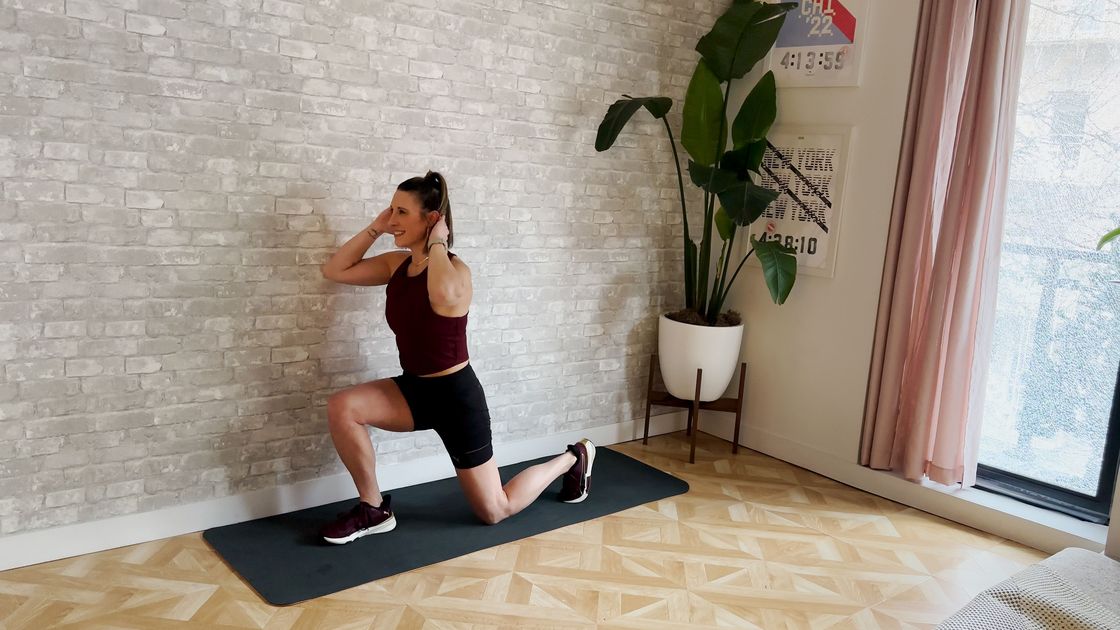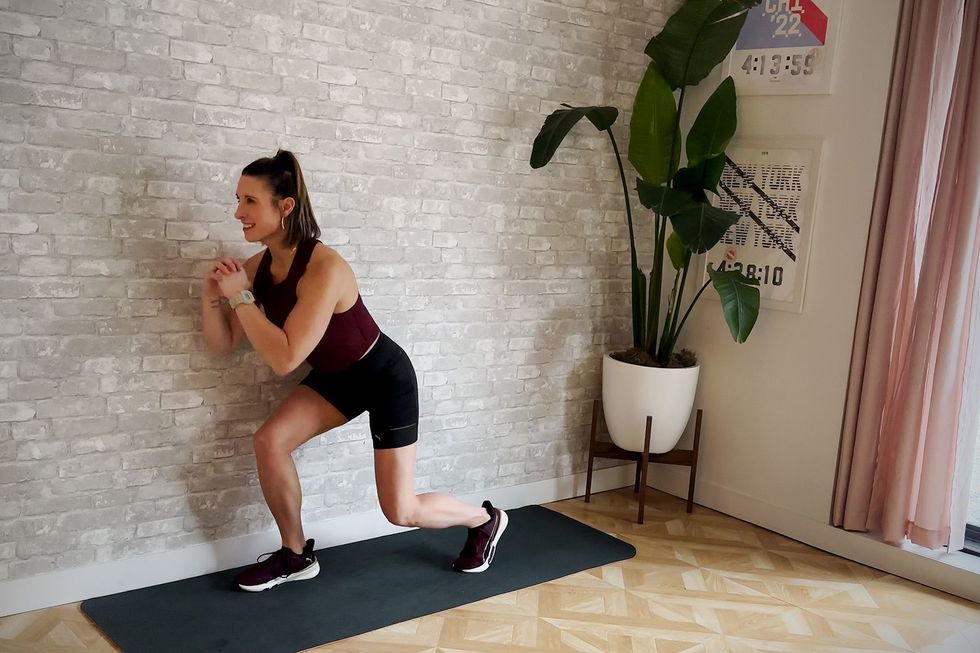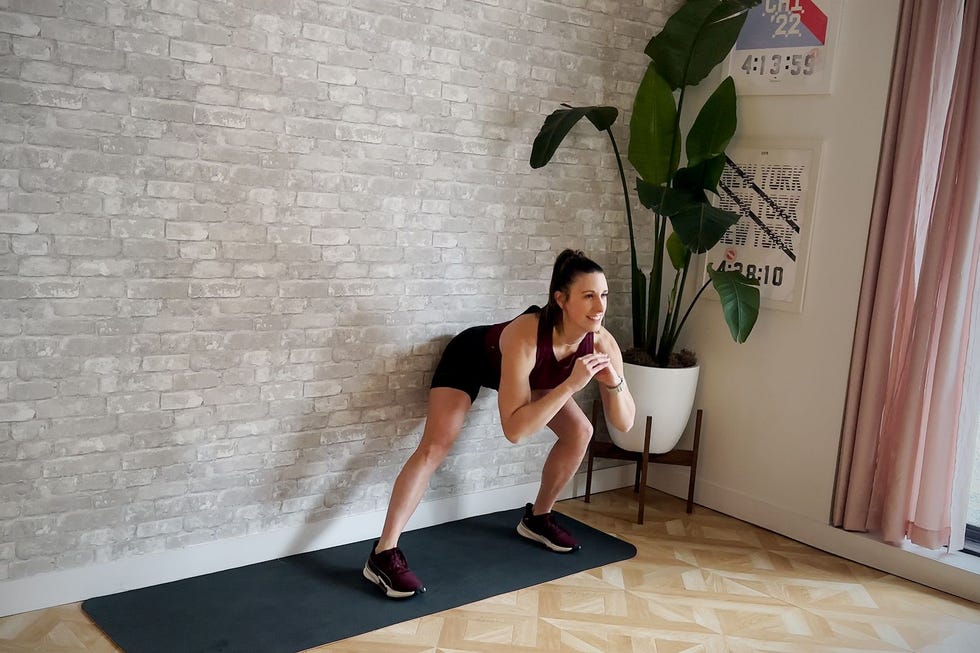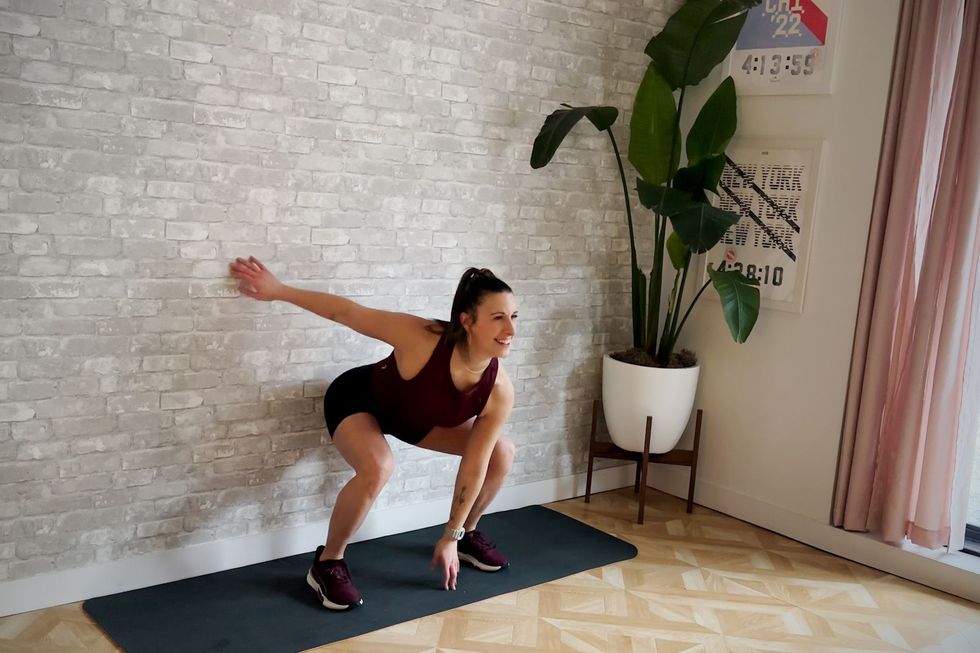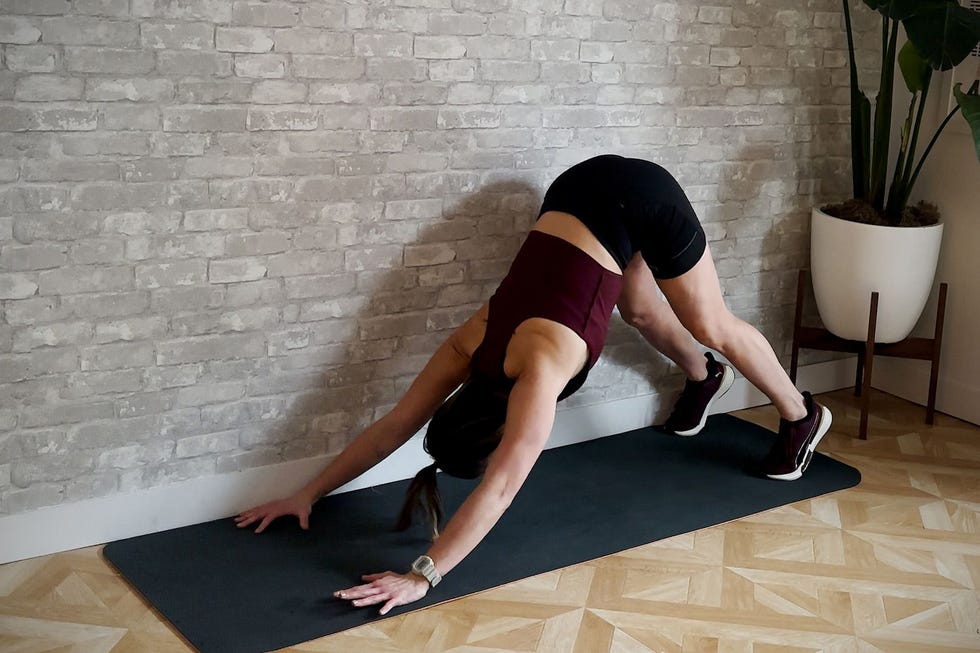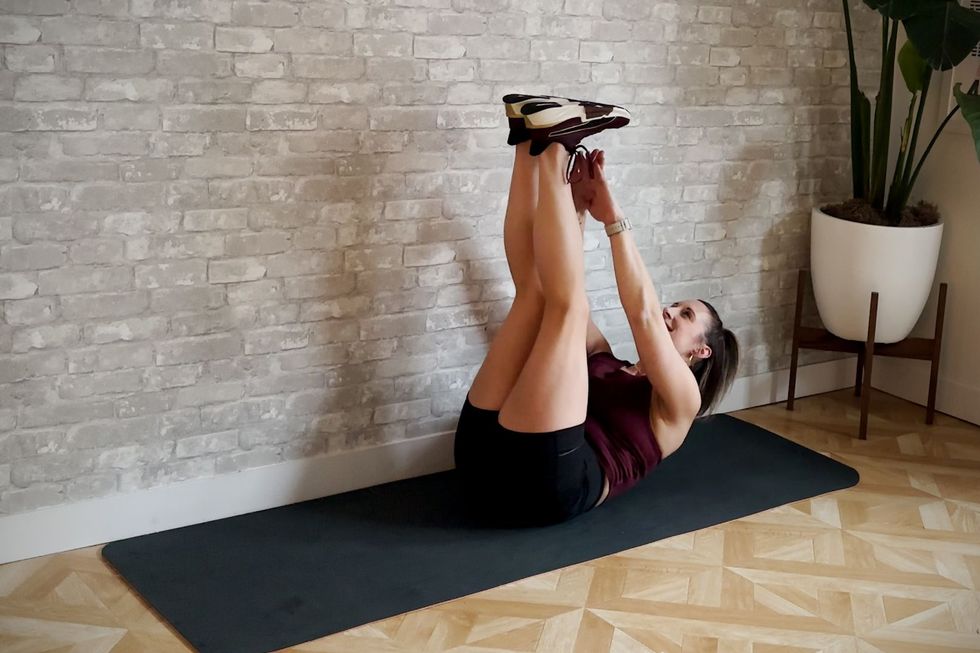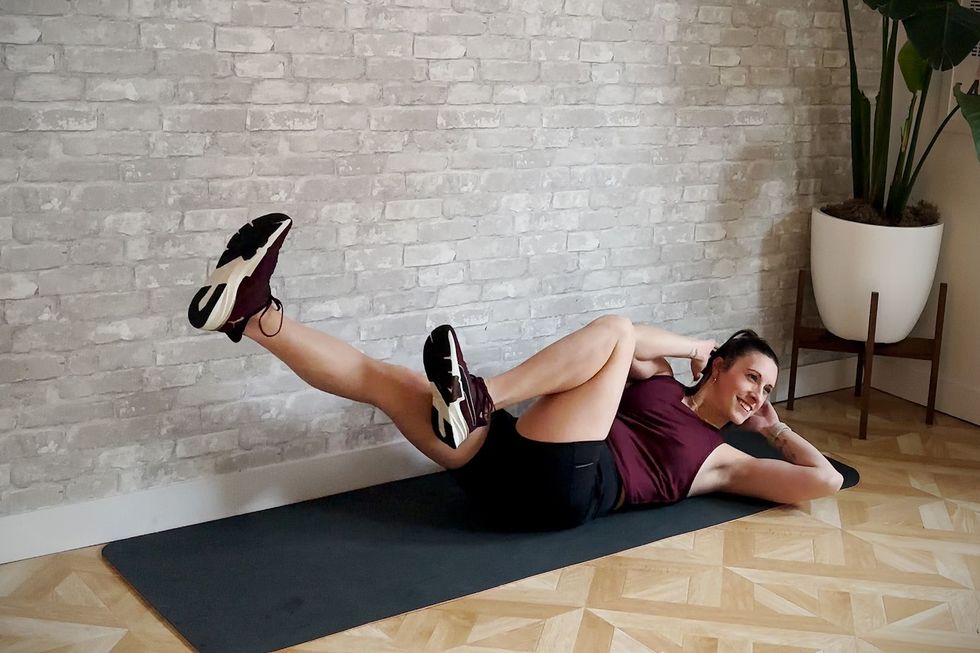As a long-distance runner, you want to practice aerobic workouts on the regular. They help you build the stamina needed to make it through many miles and to pick up the pace when required. Believe it or not, all the runs you do at slow and conversational pace can be classified as this type of workout. So, you’re probably already a head of the game.
But if you want to improve your endurance off the road—and right at home—then you'll want to add this bodyweight aerobic workout, designed by Amber Rees, senior curriculum lead at Barry’s in New York City, and co-founder of the Brave Body Project, to your training schedule.
The Benefits of This Aerobic Workout for Runners
These nine exercises make a great cardio mash-up for runners who are looking for unique ways to improve or maintain their aerobic fitness. That’s because it’s bodyweight only (no need for fancy equipment!) and you can practice it anywhere (all you need is an exercise mat-sized space!).
The benefits of doing aerobic exercise, like this workout, includes improving your cardio capacity, so your body learns to more efficiently use oxygen for energy. This makes your runs feel easier, helping to lower your heart rate and keep you from huffing and puffing.
In addition to improving your cardio, this workout also helps you build total-body strength. More specifically, the first half of this workout will help runners build strong quads, glutes, and hamstrings for a more “powerful stride and to improve run efficiency,” Rees says. And the second half of the workout will target your upper body—most importantly, your core—for better posture and stability.
So, if you’re looking for a quick 20-minute routine you can do before you head to work or you want something to make you sweat on a rainy day in place of a run, this workout will do just that.
How to use this list: Perform each exercise below in order for 60 seconds each with little to no rest in between each exercises. Recover for 60 seconds, then repeat the entire list.
You will not need any equipment for this workout, though an exercise mat is optional. Each move is demonstrated by Rees in the video above so you can learn the proper form.
1. Good Morning
Why it works: Activate the posterior chain—muscles we tend to neglect—including the back, glutes, and hamstrings with this exercise. Strengthening these muscles gives you more power on the run.
How to do it: Stand with feet hip-width apart and both hands behind head. With a slight bend in the knees, and core engaged, hinge at the hips by sending butt straight back. Maintain a flat back. Then, drive through feet to stand back up, extending hips. Repeat.
2. Squat to Tap Back
Why it works: This lower-body exercise targets the main muscles used in running, like your quads and glutes.
How to do it: Stand with feet a bit wider than shoulder-width apart and hands clasped together in front of chest. Send hips back and down to lower into a squat. Pause at the bottom, core engaged, and step back with right foot into a lunge position. Then return right foot to squat position. Next, step back with left foot into a lunge position. Then return it to squat position. Drive feet into the ground to stand back up. Repeat.
3. Side Lunge
Why it works: It’s crucial for runners to work in alternate planes of motion, besides the typical front-to-back. This exercise gets you to move laterally, targeting hip abduction, which is important for glute strength and injury prevention.
How to do it: Stand with feet hip-width apart and toes pointing forward. Clasp hands in front of chest. Take a big step to the left with left foot, bending knee and sending hips back. Keep right leg straight. Make sure weight is in the heel of left foodt and knee and toe point forward. Then drive through left foot to stand up and step foot back to hip-distance from right. Repeat on right side. Continue alternating.
4. Single-Leg Deadlift to Lunge
Why it works: Challenge that balance! This move works single-leg stability, a crucial element of running.
How to do it: Stand with feet hip-width apart, hands behind head. Shift weight to left leg, lift right heel and place right toes in line with left heel. Engage core and hinge at the hips by sending butt straight back for the deadlift. Then drive through left foot to stand back up, extending hips. Next, step back with right foot into a reverse lunge, both knees bending about 90 degrees, back right knee hovering just off the ground, and left knee tracking over toes. Drive through feet to stand up, right foot stepping forward. Repeat on the other side. Continue alternating.
5. Pop Squat
Why it works: This plyometric exercise helps runners build lower-body strength and explosive power for faster runs.
How to do it: Stand with feet a bit wider than shoulder-width apart, toes turned slightly out. Send hips back and down, bending knees to lower into a squat and touch ground with right hand. Jump up, exploding off the floor to bring feet together. Then jump back out to a squat position, landing low with knees bent, this time touching ground with left hand. Repeat.
6. Push-up to Downward Dog
Why it works: Work your shoulder stability and target core strength with this dynamic move, which also stretches the calves and hamstrings in the downward dog.
How to do it: Start in a plank position, shoulders over wrists, forming a straight line from head to heels. Maintaining that straight line, bend elbows and slowly lower entire body to floor. Exhale and slowly straighten elbows to push back up to a plank. Then lift hips up and back, chest coming between arms, to form an upside down V shape for your downward dog. Pause, then return to plank. Repeat.
7. Triceps Dip
Why it works: Target the back of your arms, specifically your triceps, with this exercise that assists in a stronger arm drive.
How to do it: Start seated, knees bent and feet flat. Place hands behind hips, fingers facing you. Lift hips off ground. This is your starting position. Bend elbows to lower hips to ground. Then press back up to starting position. Repeat.
8. Leg Lift to Toe Touch
Why it works: Work those abs with this exercise that requires stability through your midsection as you move your arms and legs—just like on the run.
How to do it: Lie faceup with legs straight and feet in the air, arms straight above chest. Lower feet down to the ground while simultaneously lowering arms behind head. Keep back flat against mat. Lift arms and legs back up to center. Then, lift head, neck, and shoulders off the ground to reach for toes with both hands. Lower upper body back to floor. Repeat.
9. Bicycle
Why it works: Build strength in the obliques, which help to keep you upright and stable as you clock miles.
How to do it: Lie faceup, hands behind head, elbows wide, head, neck, and shoulders off the floor. Bend knees and hold them above hips. Extend right leg and rotate torso to the left, reaching right shoulder to left knee. Return through center, and extend left leg, rotating torso to the right, left shoulder to right knee. Continue alternating.

Monique LeBrun joined the editorial staff in October 2021 as the associate health and fitness editor. She has a master’s degree in journalism and has previously worked for ABC news and Scholastic. She is an avid runner who loves spending time outside.
